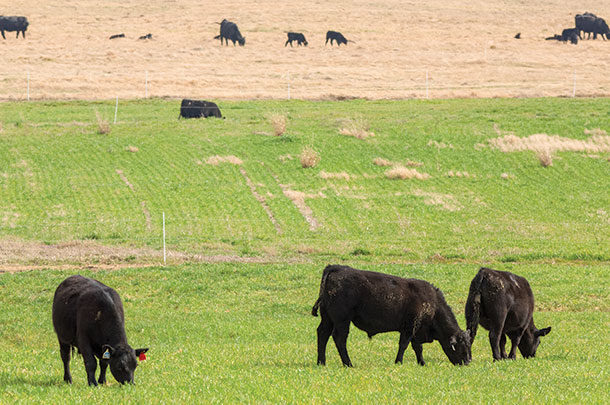Small-grain winter annual grass crops are commonly used as forages across the U.S. in many livestock production systems as grazed and stored (hay and silage) forages. Small- grain crops include wheat, oats, rye, triticale and barley.
They can produce large volumes of high-quality forage within short periods of time, usually during the fall and spring seasons. These forages are most cost-effective for growing and lactating livestock but are occasionally used for other classes of livestock as a supplement or to obtain rapid gains on mature animals.
In beef systems, small grains are usually grazed by yearling cattle with the excess hayed if weather permits. Dairies frequently use small grains as silage for dairy cow diets, although some small-grains pasture is grazed and hayed.
The peak growing season for a small-grain grazing crop is determined by the forage species, the way it is planted and the weather. Obviously, weather that detrimentally impacts the germination and growth of the crop will affect the production of that crop.
Environmental conditions in the southern U.S. allow for fall and winter grazing due to milder conditions during the cool season. In northern climatic zones, small-grain grazing may be limited to the spring. Hay and silage production from small-grain forage peaks in the spring in the south and early summer in the north.
Typically, small grains are produced on cropland where soil quality does not limit production. Due to large seed size, small grains are easily established using a number of techniques including conventional seedbed preparation and drilling, no-till planting practices, and cultivation and broadcast seeding.
To produce enough forage for early grazing in the milder winter climates of the U.S., small grains should be planted in early September either no-tilled or into a prepared seedbed.
In the South, small grains are sometimes overseeded into a warm-season perennial grass pasture late in fall (October or November) after the summer grass has dramatically slowed its growth or earlier (September) if the warm-season grass is treated with an herbicide to depress its growth.
If small grains are planted in late fall, or without suppression of the perennial pasture, fall forage is rarely obtained but good spring grazing can occur.
Fertilizer rates for small grains grown for grazing vary based on yield goal and the amount of residual nitrogen in the soil. A general recommendation of 100 pounds actual nitrogen per acre plus lime, phosphorus and potassium based on soil test results should grow enough forage to produce 400 to 500 pounds of beef per acre on productive soils with good stands of grass.
In the South, all the fertilizer can be applied at or near planting time if good early-season grazing is desired. The nitrogen rate can be split between planting time and February if a more uniform volume of grazing throughout the season is desired or in high rainfall regions of the U.S.
In the North, where small grains for forage production are relegated to the spring and summer, nitrogen is usually applied in the spring. For silage production, yield goals will determine the amount of nitrogen to be applied with rates in excess of 200 pounds actual nitrogen being common.
The major small-grain species used for forage production in the South are wheat, rye, oats and triticale. Barley is used to a lesser extent but is more commonly used in the northern states. These are discussed below:
Wheat (Triticum aestivum) – Wheat is the most commonly planted small- grain species for grazing in the U.S. for several reasons. The main reason is that it can be used dual-purpose for both grazing and grain. Seed is available almost everywhere; it is cold hardy and is unlikely to be considered a weed in subsequent crops, and good data exists to make variety selections.
Compared to the other small-grain species, wheat is below average in the amount of early growth and total forage yield obtained but makes adequate amounts of high-quality forage to satisfy most producers. Wheat is considered more tolerant of wet clay soil areas than the other small-grain species. It is usually planted at a rate of about 90 to 120 pounds of seed per acre at 1 to 2 inches deep.
 These cattle are grazing rye. Photos provided by Eddie Funderburg.
These cattle are grazing rye. Photos provided by Eddie Funderburg.
Rye (Secale cereale) – The main advantages of rye are that it produces more early-season forage, more fall forage in southern climates and more total forage than wheat. It matures earlier in the spring than wheat, which is an advantage if it is overseeded into warm-season perennial grasses (southern U.S.), or if a warm-season annual crop is desired in the summer.
The major disadvantage is that it is considered a very bad weed in wheat grown for grain, so it should not be planted in areas expected to be used for grain production in the future. Also, seed can be difficult to find. Since rye matures earlier than wheat, rye grown for seed is susceptible to late-spring freezes.
Rye often excels in sandy soils and is considered more acid-tolerant than wheat. It is usually planted at a rate of 90 to 120 pounds of seed per acre at 1 to 2 inches deep.
Oats (Avena sativa) – The primary advantage of oats is that they produce the most early-season forage of any small grain. The major disadvantage is it is the least winter hardy of the small grains grown in the southern U.S. In the South, oats are often grown in combination with other small grains like wheat or rye.
Oats will produce early forage; if it dies in the winter, the other species will replace them in the spring grazing phase. Oats can also be planted in late winter or early spring to produce spring grazing or hay. Oats make more forage in a short time than any of the other small-grain species grown in the South.
Oats are usually planted at a rate of 60 to 90 pounds of seed per acre if sown with other winter annuals or at a rate of 90 to 120 pounds of seed per acre if planted alone. Oats should be planted 1 to 2 inches deep.
Triticale (Triticum secale) – Triticale is a crop species resulting from a cross between rye and wheat with the average characteristics of each. In other words, it has earlier maturity than wheat but later than rye.
It produces forage yields a little higher than wheat but a little lower than rye. Triticale is considered a weed in wheat grown for grain, so it should not be planted in fields where wheat may be grown for grain in the future. Triticale is planted at the same seeding rate and depth as wheat.
Barley (Hordeum vulgare) – Barley is grown for grazing or silage by some ranchers in the South but is more common in the northern states. The major advantage to barley is its tolerance of soils high in soluble salts or sodium.
The major disadvantage is poor seed availability in many areas of the U.S., especially in the southern states. Barley is planted at the same seeding rate and depth as wheat.











